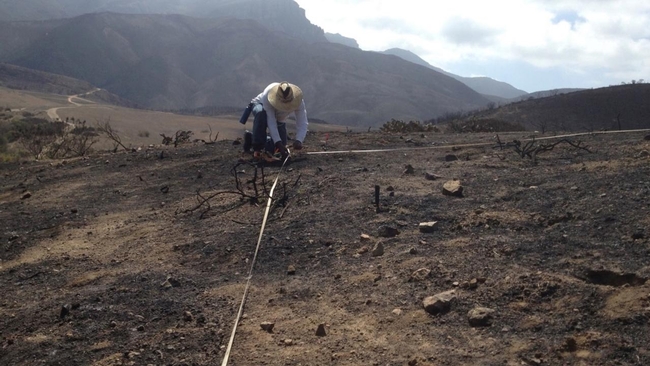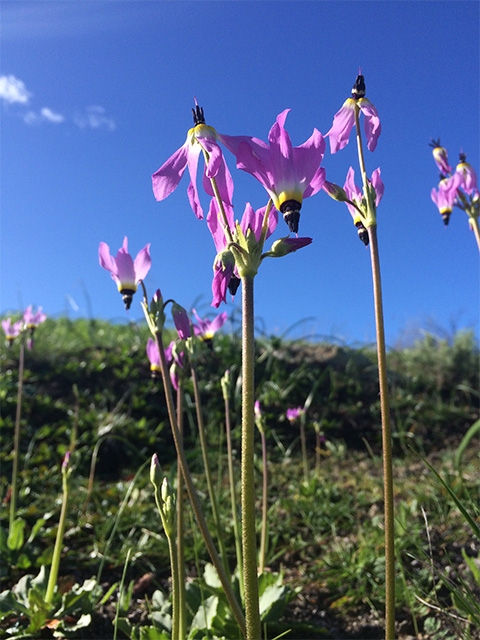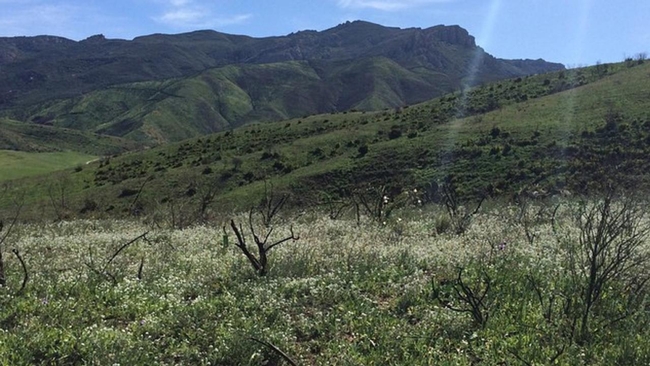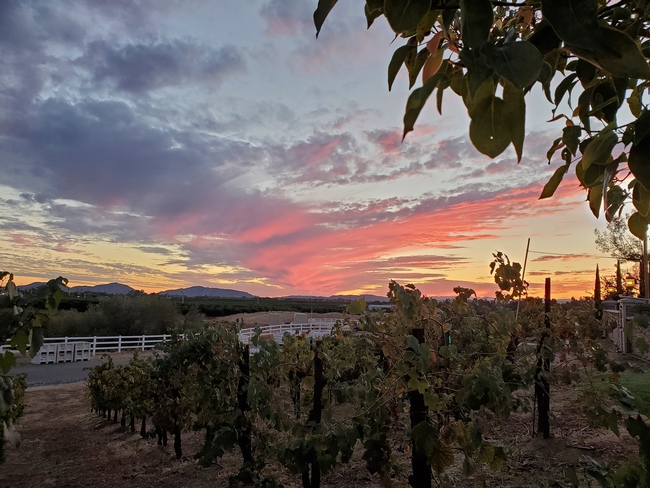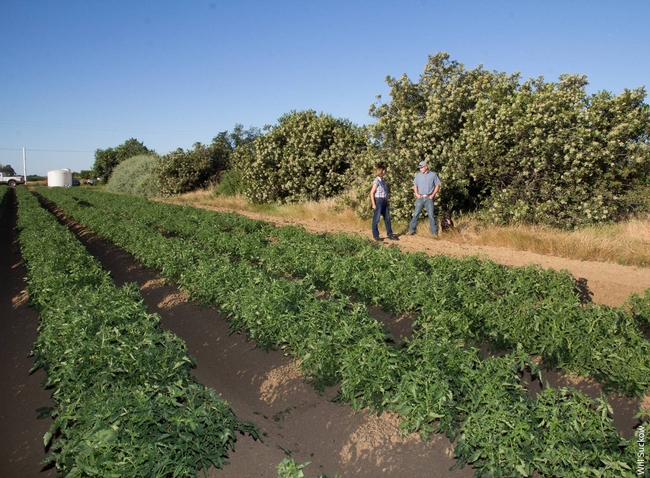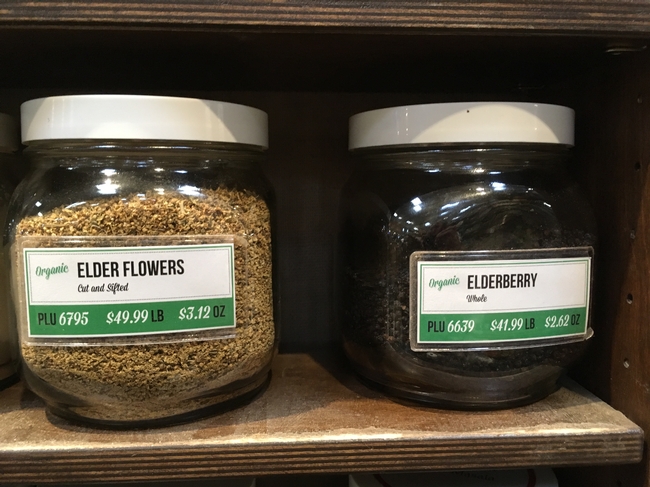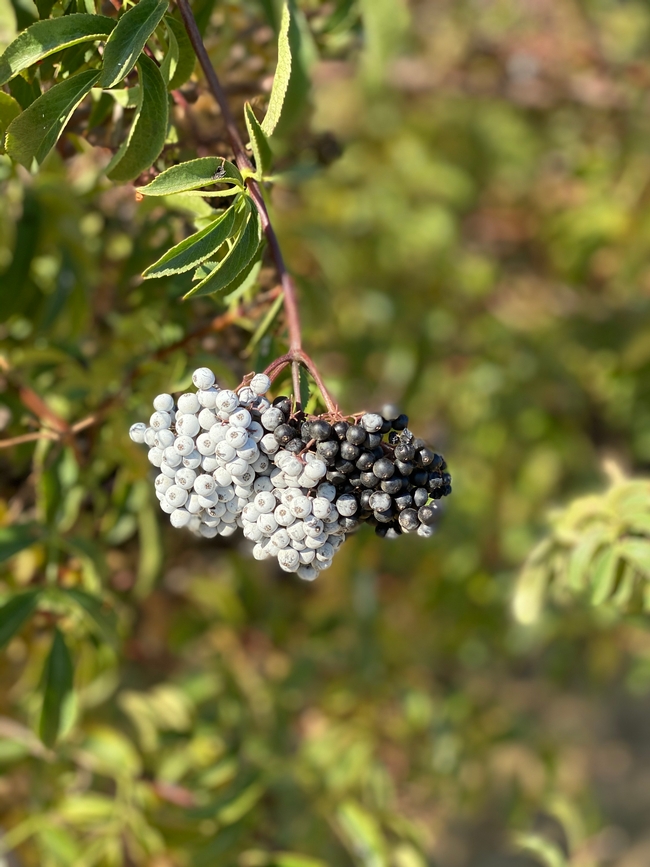Posts Tagged: plants
Car fumes, weeds pose double-whammy for fire-loving native plants
Wildflower displays threatened
Northwest of Los Angeles, springtime brings native wildflowers to bloom in the Santa Monica Mountains. These beauties provide food for insects, maintain healthy soil and filter water seeping into the ground – in addition to offering breathtaking displays of color.
They're also good at surviving after wildfire, having adapted to it through millennia. But new research shows wildflowers that usually would burst back after a blaze and a good rain are losing out to the long-standing, double threat of city smog and nonnative weeds.
A recent study led by Justin Valliere, assistant professor in the UC Davis Department of Plant Sciences, found that native wildflowers and other plants that typically flourish following a fire were, instead, replaced by invasive plants on land that received the kind of nitrogen contained in vehicle emissions.
“Many native plants in fire-prone areas rely on fire, and some are entirely dependent on it. Some are even most abundant after a fire,” said Valliere, a UC Cooperative Extension specialist in invasive weed and restoration ecology. “But we found that these fire-following species may be especially vulnerable to the combination of nitrogen pollution and invasive plants.”
That's part of the reason why native plants in these mountains have been declining.
Seeds – banked in the soil and waiting to sprout
The problem faced by native plants can be compared to a drawn-down bank account: Funds withdrawn are not being replaced.
It starts with fire, an important ecological process, Valliere said. Flames burn through plants on the surface and return their nutrients to the soil. Seeds sleeping in the ground wait for the next rain to sprout, then use those nutrients to grow.
“Plant diversity is often highest in growing seasons immediately after a site burns,” he said.
But invading plants have many advantages over native ones. They often sprout earlier, grow faster and create more seeds, all while tolerating drought.
“They're like cheaters,” Valliere said. “They don't follow the same rules.”
Nitrogen, too, is an important piece of every plant's nutrition. They all get a fertilizing boost from nitrogen that floats up in vehicle emissions and falls to the ground. But the invaders use nitrogen and other nutrients to grow faster, winning the race for water and sunlight. As a result, fewer native plants reach maturity, producing fewer seeds that keep their populations thriving.
When the bank balance reaches zero
The 2013 Springs Fire gave Valliere a unique opportunity to study the combined impacts of wildfire and extra nitrogen. He and colleagues from UC Riverside and the National Park Service created test plots in the Santa Monica Mountains where the fire had burned. Then, they added nitrogen to the soil to mimic the amount and type that LA's smog would deposit. Over the study's three years, native plants that typically would have flourished after wildfire instead declined even faster in the plots with added nitrogen.
Native seeds sprouted, but didn't flower. Over time, the soil's bank of seeds drew down.
“Each seed has one chance to flower and reproduce,” Valliere said. “If a seed grows and gets outcompeted, that seed has lost its chance to replenish the seed bank.”
Without the chance to replenish their bank account, native plants will die out, and the whole ecosystem will be thrown out of balance.
“There is inherent value in biodiversity,” Valliere said. “These invasive weeds could prevent the re-establishment of native shrubs after fire, sometimes forever altering the plant community.”
The loss of native plants can have cascading effects on the larger environment, he added. Problems can include the loss of native bees that feed on the flowers, and mudslides when rain makes hillsides unstable.
This problem is likely to repeat in similar areas where biodiversity is highest after wildfires – including parts of the Mediterranean basin, southern Africa and Australia. The addition of city smog “could have serious consequences for the biodiversity of fire-prone ecosystems worldwide,” Valliere warned.
Read the paper, “Nitrogen deposition suppresses ephemeral post-fire plant diversity,” by Justin Valliere, Irina Irvine and Edith Allen.
This article was first published on the UC Davis Department of Plant Sciences website.
Your water-efficient landscape doesn’t have to be barren
UC climate-ready landscape trials identify low-water yet attractive plants
Good news: roses can be a part of your water-efficient landscape. Lorence Oki, UC Cooperative Extension environmental horticulture specialist in the UC Davis Department of Plant Sciences, identified rose cultivars that remain aesthetically pleasing with little water.
Oki is the principal investigator of the Climate-Ready Landscape Plants project, which may be the largest irrigation trial in the western U.S., and the UC Plant Landscape Irrigation Trials (UCLPIT), the California component of that project. These projects evaluate landscape plants under varying irrigation levels to determine their optimal performance in regions requiring supplemental summer water.
“There are some assumptions that pretty plants use a lot of water, like roses,” Oki said. “Everyone thinks they need a lot of water, but we've found some that don't, and they still look great. A water-efficient landscape doesn't need to look like a Central Valley oak-grassland in the summer. It can look really attractive.”
In 2021, Oki's team at UC Davis identified Lomandra confertifolia ssp. pallida "Pom Pom" Shorty and Rosa "Sprogreatpink" Brick House® Pink as two of the best low-water plants in the trial. 
“The useful tip or information that is shared at the end of each trial is the selection and designation of plants as Blue Ribbon winners. These are the plants that looked good with an overall rating of 4 or higher throughout and were on the low (20%) water treatment,” said Natalie Levy, associate specialist for water resources, who manages the project at the UC ANR South Coast Research and Extension Center.
How plants earn a blue ribbon
Each trial year, the selection of new plants is based on research recommendations and donated submissions from the nursery industry. The landscape plants are trialed in full sun or 50% shade cover.
Irrigation treatments are based on the rate of evaporation and plant transpiration (evapotranspiration) measured through a local California Irrigation Management Information System (CIMIS) weather station that provides a reference evapotranspiration (ETo) rate.
Three levels of irrigation are provided to the plants equal to 20%, 50%, and 80% of ETo. The volume of water applied is the same at each irrigation based on soil characteristics, but the interval between applications varies with weather and the treatment. Using this method, irrigations for the 20% treatment are less frequent than the 80% treatment.
“The 20% treatment during the 2022 trial was irrigated an average of once per month while the 80% treatment was irrigated weekly,” explained Levy.
During the deficit irrigation trial, monthly height and width measurements are taken to determine the plant growth index. Monthly qualitative aesthetic ratings on a scale of 1 to 5 are determined for foliage appearance, flowering abundance, pest tolerance, disease resistance, vigor and overall appearance.
A second round of flowering abundance and overall appearance measurements are also taken to capture more of the blooming period. For example, UCLPIT identified in the 2020 trial at South Coast REC that the "Apricot Drift" rose had a mean overall appearance score of 3.5 out of 5, deeming it “acceptable to very nice” and a low water use plant within the Water Use Classification of Landscape Species or WUCOLS guide.
Project expands options for landscape planting

“(WUCOLS) only has 3,500 plants in it. There are guesses that there are close to 10,000 cultivars in urban landscapes in California, if not more,” said Oki. “WUCOLS also didn't have numerical ratings. Instead, you'll see verbal ratings like ‘low water use' or ‘high water use.'”
The UCLPIT project has not only developed numerical recommendations for irrigation, but it has also added new landscape plants that are compliant with California's Model Water Efficient Landscape Ordinance. In fact, UCLPIT's data is one of the few sources that can be used to supplement WUCOLS.
Geographic diversity of trial sites adds to knowledge base
In addition to UC Davis and South Coast REC in Irvine, the trials have expanded beyond California as the Climate-Ready Landscape Plants project and is in progress at Oregon State University, University of Washington, University of Arizona and Utah State University thanks to a USDA/CDFA grant awarded in 2020.
Lloyd Nackley, associate professor of nursery production and greenhouse management at Oregon State University, is the principal investigator of the trial in the Portland metro area, which is entering its third year.
“People know that there are drought tolerant plants, but there are many. We're trying to highlight lesser known or newer varieties. And even though the trial is three years, most gardeners would hope that their garden lasts longer than that,” said Nackley.
One of the observations that Nackley recalls is of the Hibiscus Purple Pillar plant. Unlike the trial at South Coast, the Purple Pillar did not perform well in Oregon in the spring.
“It wasn't until August that we saw the plant bloom and begin to look like what we saw from South Coast in April,” Nackley said.
Ursula Schuch, horticulture professor and principal investigator of the trial taking place at the University of Arizona, was also surprised at the range of performance among different plant types and the effects of irrigation, heat and temperature.
“This research will reassure green industry professionals that they can stretch their water budget to successfully cultivate more plants, watering them according to their needs instead of irrigating every plant according to the highest water-using plants,” said Schuch.
Although research is only conducted in the West, the hope is that there will be trials in other regions of U.S.
Doing so would yield comprehensive information about the plants and their performance in different climates. As extreme weather events persist in the U.S., disease pressure and risks do too. Trials throughout the country would provide location-specific data regarding disease susceptibility.
To learn more about the UCLPIT research project, visit https://ucanr.edu/sites/UCLPIT/
Suppliers, retailers warn California grape growers of herbicide shortages
Supply-chain crisis forces some to pivot to mechanical, biocontrol measures
Driving through her vineyards on a chilly morning in December, Hortencia Alvarado is taking comfort – for now – that the weeds she sees are all yellow. But there remains a nagging worry that, like the pesky plants, is merely lying dormant for the season.
When March rolls around, and the first signs of new green growth appear on the vines, Alvarado and other vineyard managers will again have to confront the ongoing shockwaves of the global supply-chain crisis.
Growers of grapes – the third-highest valued agricultural commodity in California at $4.48 billion in 2020 – likely won't be able to access the herbicides that they usually apply.
“I definitely need to start thinking and considering it because I don't want to be in that situation where I don't have [the herbicide] when I need it,” said Alvarado, a vineyard manager in the San Joaquin Valley.
Imperfect alternatives
She first noticed the effects of the shortages this past August, during the application following the harvest of early varietals. Alvarado's agricultural pest control adviser had recommended a different product, instead of their usual standby, Rely – because none of the handful of suppliers in California could find it.
Then Alvarado's foreman started reporting that the substitute wasn't controlling the weeds.
“We were using some other stuff that wasn't as good, so basically we were wasting money on stuff that wasn't doing what we wanted it to do,” Alvarado explained.
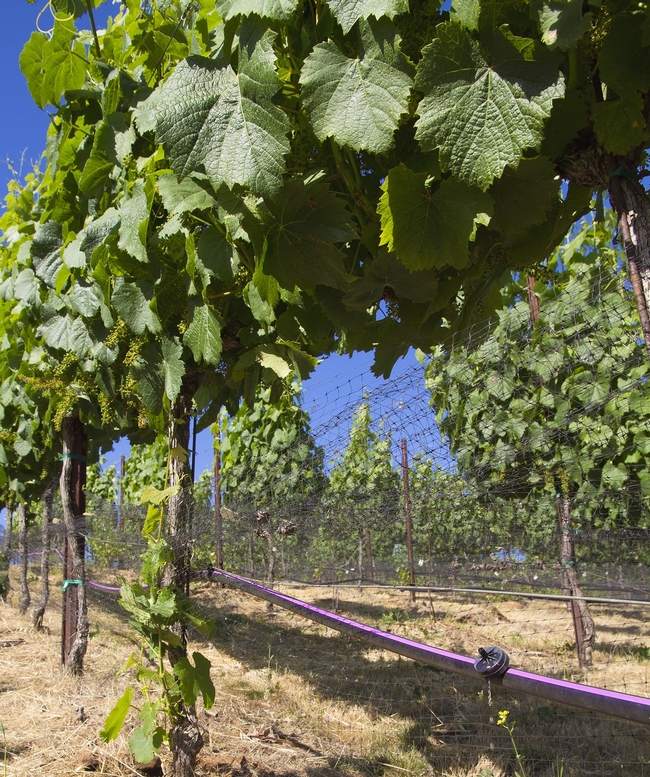
The need for more machines or labor is just one result of the herbicide shortage, said George Zhuang, University of California Cooperative Extension viticulture farm advisor in Fresno County. Zhuang has received “a lot” of calls from growers about the chemical supply issues, which are also affecting fertilizers. He's been urging them to move away from traditional herbicides to mechanical means or biocontrol such as sheep or fowl – even though they might be more expensive.
Zhuang estimates that while a weed program comprises 5% to 10% of total production costs in a normal year with the usual herbicides, the use of nonchemical alternatives could hike that percentage up to 10% to 20%. In addition to their impact on the bottom line, effective herbicides are especially crucial to grape growers because vines – unlike tree crops – cannot naturally shade out weeds with expansive canopies.
“Right now, people can still scramble around and find some limited chemicals to make sure the crop is successful for the harvest, but if the situation goes for another year, I think there's going to be a panic in farming communities,” Zhuang said.
Herbicide challenges expected to linger
Unfortunately, the availability of certain products is likely going to be “challenged” into at least the middle of 2022, according to Andy Biancardi, a Salinas-based sales manager at Wilbur-Ellis, an international marketer and distributor of agricultural products and chemicals. Biancardi said that the suppliers he talks to are advising people to make preparations.
The supply of glyphosate, the key component in products such as RoundUp (used by many Midwestern farmers), appears to be most affected, Biancardi said. As a result, that shortage has put the squeeze on alternatives such as glufosinate, used in products like Rely – the herbicide favored by many California grape growers.
“The cost of glufosinate has definitely gone up because there just isn't enough, so everyone is obviously marking it up,” said Biancardi, who estimates that prices for both glyphosate and glufosinate are up 25% to 30% for growers.
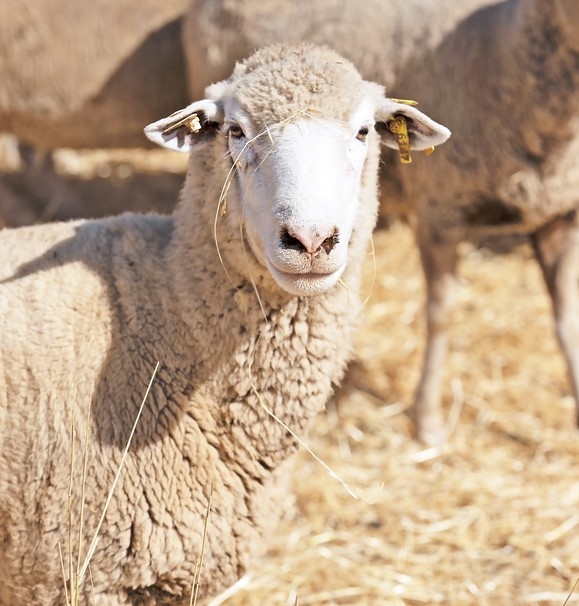
Alvarado said that while large commercial operations are able to pay the premium prices or shift to other weed control measures, some smaller growers have essentially given up the fight – simply letting the weeds take over.
“They're just letting it go wild until the dormant season,” she said. “They're hoping that – by when they do start to spray [around March] – they'll hopefully have that Rely.”
Silver lining to supply crisis?
Large-scale growers and retailers are buying up those scarcer products when they can, in anticipation of future shortages during critical times. Biancardi said that while his company traditionally runs inventories down at the end of the season, they are instead stocking up on herbicides that customers will demand.
“Careful planning and forecasting is going to be more important than ever, that's really the key,” he said. “At this point we can't guarantee ‘business as usual,' based on what we're hearing.”
Shaking off old habits might actually bring some benefits to business, according to Alvarado, as a forced shift away from chemicals could prove to be a selling point for customers, from a sustainability and marketing standpoint.
“Out of this shortage, there might be some good, some wins,” she said, “but at the same time, we're going to need some answers – I think it's going to be a bumpy road.”
Calling the confluence of drought, record heat and a shortage of chemicals a “perfect storm,” Zhuang said that consumers could start feeling those jolts as well.
“Eventually, somebody is going to eat the costs – either the farming community or the consumer is going to eat the cost, I hate to say it,” he said.
Growing elderberries in hedgerows adds to farm income, benefits environment
As the sustainability of agriculture continues to be threatened by changes in climate, pests and loss of biodiversity, the ancient practice of planting hedgerows with edible and medicinal species such as elderberry can help growers generate additional revenue while fostering beneficial insects and improving soil health.
Most modern-day farmland is occupied by simple “monocrop” systems that often require frequent, energy-intensive inputs like synthetic fertilizers and pesticides to sustain their yields. These practices can be harmful to water quality, biodiversity and soil health.
But farmers who incorporate perennials into their farm landscapes can better harness living things—crop plants, pollinators, beneficial microbes and natural enemies of pests—to provide services rather than adding synthetic products, to the ultimate benefit of the farm and the environment.
Restoring field edges by planting hedgerows is a common way to add perennials to farm fields without taking land out of production. These managed rows of trees, shrubs, grasses and wildflowers were an ancient feature of agricultural landscapes throughout the world.
As farmland industrialized in Europe and North America in the 1900s, many old hedgerows were removed. But hedgerows have seen a resurgence in recent years as their significant environmental benefits—including natural pest control and pollination services, improved soil health and carbon sequestration—are increasingly recognized.
With hedgerows, “the whole farm can be a site of both conservation and profitability,” says Sonja Brodt, deputy director of the University of California Sustainable Agriculture Research & Education Program (UC SAREP).
Hedgerows can be costly to establish, and this is often the reason farmers choose not to use them. But incorporating a harvestable crop into a hedgerow can be profitable.
Brodt is leading a collaborative effort with California farmers and UC researchers to develop native western elderberry as a hedgerow cash crop. Blue elderberry (Sambucus nigra ssp. cerulea) is a native subspecies of elderberry that is well-adapted to Mediterranean climates and grows prolifically across California. It is thought to be more heat- and drought-tolerant than the more commercialized North American and European subspecies of elderberry.
“Elderberries have this great potential as a ‘win-win' crop. Farmers harvesting and selling elderberries from their hedgerows can receive a direct income from a farm practice that benefits the local ecosystem,” says Brodt.
Consumer demand for elderberry-based products has skyrocketed in recent years. Blue elderberry has similar antioxidant levels to blueberries and can be processed into products such as jams, syrups, tea mixtures and herbal supplements.
“We found that two-thirds of surveyed herbal and specialty foods processors and retailers were strongly interested in sourcing California-grown elderberries and couldn't find enough supply to meet their needs” says Gwenaël Engelskirchen of UC SAREP. Farmers who grow blue elderberry can tap into this growing market.
The research team recently completed a field trial in the southern Sacramento Valley to assess the profitability of blue elderberry. They found that elderberry yields from a 1,000-foot, multispecies hedgerow could provide $2,700 to $4,800 in revenue, after harvest and de-stemming costs, in only the second year after hedgerow planting. This revenue helps offset typical hedgerow establishment costs of $3,000 to $4,000, and elderberry revenue is expected to grow over time as the plant yields continue to increase. Value-added processing and specialty products made on-farm could also increase overall profitability.
While native elderberry hedgerows is a new area of research for the University of California, North America's indigenous people have been harvesting and tending blue elderberry in California for hundreds of years. Many Native persons across the state continue to gather, cultivate and use elderberry.
Sage LaPena, Nomtipom and Tunai Wintu ethnobotanist and certified medical herbalist, stresses that “elderberry is one of our most important traditional medicines and we've never stopped using it.” Cultivating elderberry for harvest could be one path towards increased food sovereignty for California's Native American tribes.
“There's an important lesson with this work,” said Brodt. “While new technologies are valuable for making agriculture more sustainable, we shouldn't lose sight of ancient practices that have benefited humanity and our landscapes over thousands of years. Hedgerows and other biological solutions are an essential piece of the sustainability puzzle. In addition, we have much to learn about the value of our native species from Native peoples and their traditional practices.”
To learn more about this research and to find educational resources for cultivating, processing, and marketing elderberry, visit https://ucanr.edu/sites/Elderberry.
New project seeks to build on the benefits of elderberries
Can plants typically grown for hedgerows also be a source of income? That's the question guiding a new UC study on the potential for farmers to grow elderberries as a commercial crop.
Blue elderberry, a California native plant with clusters of small bluish-black berries and a sweet-tart flavor, have long been eaten by Native Americans in the western states and are used today in jam, syrups, wines and liqueurs. And while elderberry orchards are popping up in parts of the Midwest, California's elderberries are usually just grown on field edges, and elderberry products sold retail rely mostly on foraged crops or imports.
Farmers at The Cloverleaf Farm near Davis are already selling elderberry products from plants grown on their farm, alongside their blackberries and stone fruits. And they find that customers love them. The farmers want to understand the viability of growing elderberries for market beyond their nascent effort, bringing some of the out-of-state production home.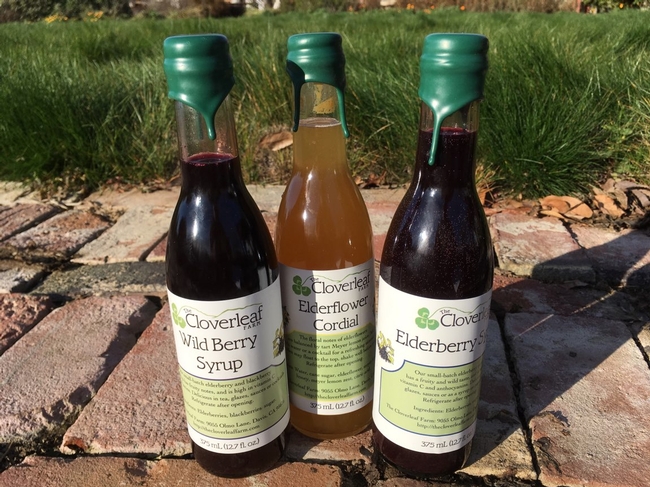
The UC Sustainable Agriculture Research and Education Program (SAREP) launched a project in collaboration with the Cloverleaf Farm, the UC Agriculture Issues Center, UC Davis Department of Food Science and Technology, and four Central Valley farmers to assess the farm management practices, nutritional content, and market potential for elderberry and elderberry products in California.
“I think a lot about the long-term systems sustainability of our food system,” said Katie Fyhrie, one of the farmers at the Cloverleaf. “I keep thinking about how much we focus on production of blackberries and blueberries, when the elderberry also achieves that dark berry color and flavor people like with much fewer resources.”
Elderberries are typically grown on farms as hedgerows for their ability to attract beneficial insects, act as a windbreak, and sequester carbon, benefiting the overall health of the farm, but not providing direct benefit to a farmer's bottom line. Despite long-running federal cost-share programs for planting hedgerows, the number planted in California is still quite small relative to the large expanses of farmland in the state. Adding a financial incentive to planting elderberries may help increase the popularity of hedgerows amongst farmers.
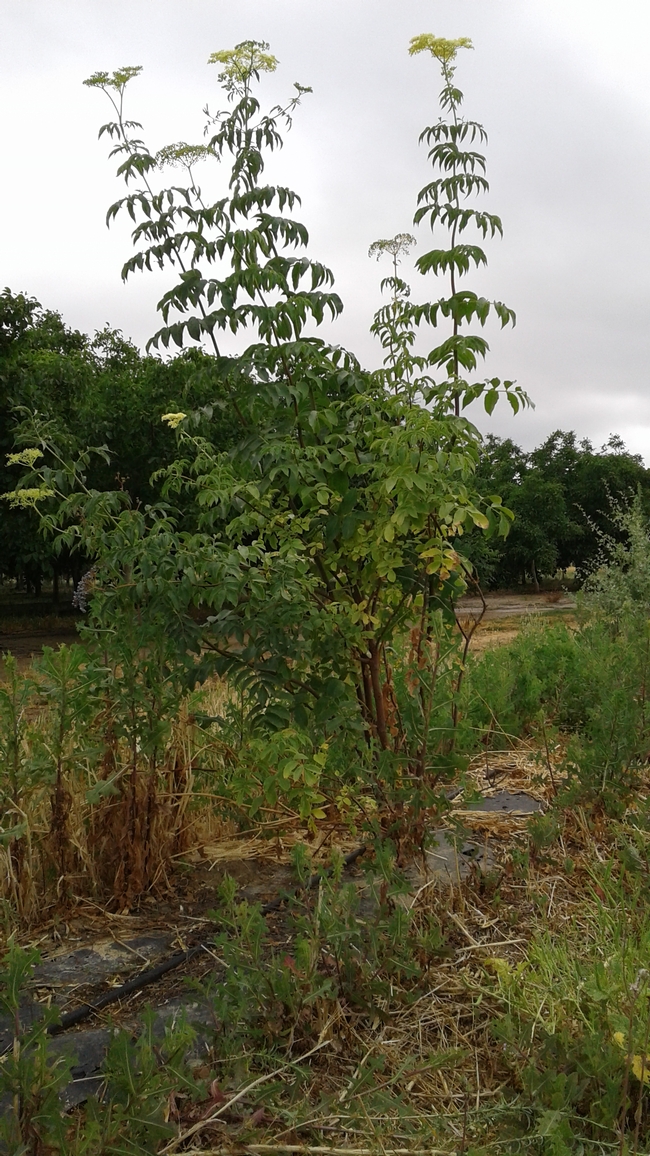
As climate change impacts California with heat and unpredictable water availability, some studies suggest farmers may need to consider diversifying the crops they grow to adapt to changing local climates.
Elderberries, which grow in arid California regions along the coast and into the mountains, have the potential to grow in a range of climates and adapt to changing California ecosystems in the future.
It is unlikely that farmers would plant entire orchards of elderberries, in part because of restrictions on pruning elderberries that may be home to the Valley elderberry longhorn beetle, a federally threatened species. But for small- and medium-scale growers looking to diversify their income sources, elderberries may provide a boost.
The two-year elderberry project now underway will conclude with a growers' production guide, cost of production study, an assessment of market demand and nutritional contents, and workshops to help link growers with buyers interested in elderberry products. The project will also address issues related to the Valley elderberry longhorn beetle and generating income from hedgerows.
“Elderberry juice is already in so many products,” Fyrhie said, “so building a market for locally grown elderberries seems like a no-lose situation.”
For farmers interested in learning more about incorporating perennials into annual crop farms and similar agroforestry practices, view a webinar on the topic recently hosted by UC SAREP here.
